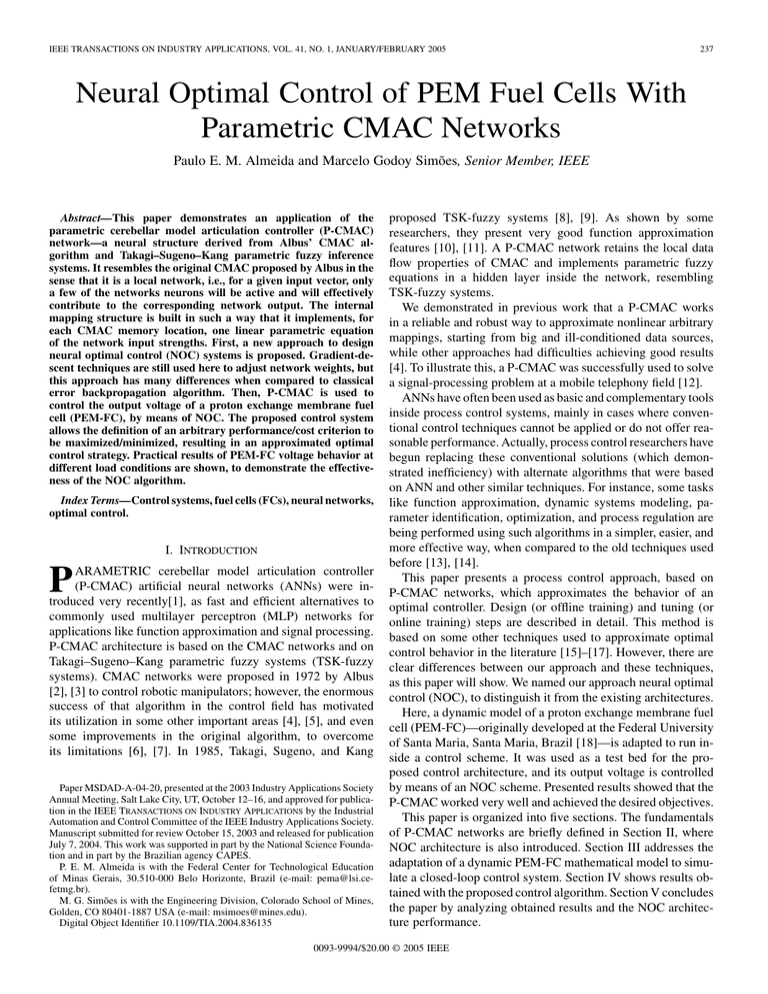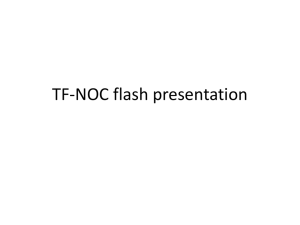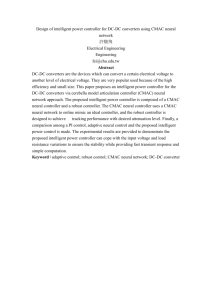Neural Optimal Control of PEM Fuel Cells With Parametric CMAC Networks
advertisement

IEEE TRANSACTIONS ON INDUSTRY APPLICATIONS, VOL. 41, NO. 1, JANUARY/FEBRUARY 2005 237 Neural Optimal Control of PEM Fuel Cells With Parametric CMAC Networks Paulo E. M. Almeida and Marcelo Godoy Simões, Senior Member, IEEE Abstract—This paper demonstrates an application of the parametric cerebellar model articulation controller (P-CMAC) network—a neural structure derived from Albus’ CMAC algorithm and Takagi–Sugeno–Kang parametric fuzzy inference systems. It resembles the original CMAC proposed by Albus in the sense that it is a local network, i.e., for a given input vector, only a few of the networks neurons will be active and will effectively contribute to the corresponding network output. The internal mapping structure is built in such a way that it implements, for each CMAC memory location, one linear parametric equation of the network input strengths. First, a new approach to design neural optimal control (NOC) systems is proposed. Gradient-descent techniques are still used here to adjust network weights, but this approach has many differences when compared to classical error backpropagation algorithm. Then, P-CMAC is used to control the output voltage of a proton exchange membrane fuel cell (PEM-FC), by means of NOC. The proposed control system allows the definition of an arbitrary performance/cost criterion to be maximized/minimized, resulting in an approximated optimal control strategy. Practical results of PEM-FC voltage behavior at different load conditions are shown, to demonstrate the effectiveness of the NOC algorithm. Index Terms—Control systems, fuel cells (FCs), neural networks, optimal control. I. INTRODUCTION P ARAMETRIC cerebellar model articulation controller (P-CMAC) artificial neural networks (ANNs) were introduced very recently[1], as fast and efficient alternatives to commonly used multilayer perceptron (MLP) networks for applications like function approximation and signal processing. P-CMAC architecture is based on the CMAC networks and on Takagi–Sugeno–Kang parametric fuzzy systems (TSK-fuzzy systems). CMAC networks were proposed in 1972 by Albus [2], [3] to control robotic manipulators; however, the enormous success of that algorithm in the control field has motivated its utilization in some other important areas [4], [5], and even some improvements in the original algorithm, to overcome its limitations [6], [7]. In 1985, Takagi, Sugeno, and Kang Paper MSDAD-A-04-20, presented at the 2003 Industry Applications Society Annual Meeting, Salt Lake City, UT, October 12–16, and approved for publication in the IEEE TRANSACTIONS ON INDUSTRY APPLICATIONS by the Industrial Automation and Control Committee of the IEEE Industry Applications Society. Manuscript submitted for review October 15, 2003 and released for publication July 7, 2004. This work was supported in part by the National Science Foundation and in part by the Brazilian agency CAPES. P. E. M. Almeida is with the Federal Center for Technological Education of Minas Gerais, 30.510-000 Belo Horizonte, Brazil (e-mail: pema@lsi.cefetmg.br). M. G. Simões is with the Engineering Division, Colorado School of Mines, Golden, CO 80401-1887 USA (e-mail: msimoes@mines.edu). Digital Object Identifier 10.1109/TIA.2004.836135 proposed TSK-fuzzy systems [8], [9]. As shown by some researchers, they present very good function approximation features [10], [11]. A P-CMAC network retains the local data flow properties of CMAC and implements parametric fuzzy equations in a hidden layer inside the network, resembling TSK-fuzzy systems. We demonstrated in previous work that a P-CMAC works in a reliable and robust way to approximate nonlinear arbitrary mappings, starting from big and ill-conditioned data sources, while other approaches had difficulties achieving good results [4]. To illustrate this, a P-CMAC was successfully used to solve a signal-processing problem at a mobile telephony field [12]. ANNs have often been used as basic and complementary tools inside process control systems, mainly in cases where conventional control techniques cannot be applied or do not offer reasonable performance. Actually, process control researchers have begun replacing these conventional solutions (which demonstrated inefficiency) with alternate algorithms that were based on ANN and other similar techniques. For instance, some tasks like function approximation, dynamic systems modeling, parameter identification, optimization, and process regulation are being performed using such algorithms in a simpler, easier, and more effective way, when compared to the old techniques used before [13], [14]. This paper presents a process control approach, based on P-CMAC networks, which approximates the behavior of an optimal controller. Design (or offline training) and tuning (or online training) steps are described in detail. This method is based on some other techniques used to approximate optimal control behavior in the literature [15]–[17]. However, there are clear differences between our approach and these techniques, as this paper will show. We named our approach neural optimal control (NOC), to distinguish it from the existing architectures. Here, a dynamic model of a proton exchange membrane fuel cell (PEM-FC)—originally developed at the Federal University of Santa Maria, Santa Maria, Brazil [18]—is adapted to run inside a control scheme. It was used as a test bed for the proposed control architecture, and its output voltage is controlled by means of an NOC scheme. Presented results showed that the P-CMAC worked very well and achieved the desired objectives. This paper is organized into five sections. The fundamentals of P-CMAC networks are briefly defined in Section II, where NOC architecture is also introduced. Section III addresses the adaptation of a dynamic PEM-FC mathematical model to simulate a closed-loop control system. Section IV shows results obtained with the proposed control algorithm. Section V concludes the paper by analyzing obtained results and the NOC architecture performance. 0093-9994/$20.00 © 2005 IEEE 238 IEEE TRANSACTIONS ON INDUSTRY APPLICATIONS, VOL. 41, NO. 1, JANUARY/FEBRUARY 2005 Finally, the output layer executes weighted summations of the neurons outputs from the internal layer, as shown by (3), and generates network outputs (3) B. NOC Fig. 1. Parametric-CMAC network basic structure. II. P-CMAC NETWORKS AND NOC A. P-CMAC Architecture P-CMAC networks aim to minimize the existing limitations of Albus’ CMAC algorithm. Non-smooth response for smooth inputs, and poor representation capabilities for complex systems (due to binary behavior of CMAC receptive fields) are two of the classical problems with those algorithms. P-CMAC networks have an important modification in their internal mapping when compared to CMAC. A CMAC internal memory is implemented as a bit memory location connected to the binary input activation functions. Fuzzy-CMAC networks use real-valued memories, and each of them corresponds to the membership grade of the input with respect to the fuzzy activation functions [4]. In a P-CMAC, these constant valued memories are replaced by parametric equations (in terms of the network inputs) and the membership grades of these inputs with respect to fuzzy activation functions. Fig. 1 shows a schematic diagram of the P-CMAC architecture. In Fig. 1, the input mapping transforms input signals into membership grades with respect to the fuzzy activation functions defined within input spaces. Equation (1) illustrates this , considering a given input and a radial basis mapping, . In this equation, activation function represented by represents the radial function center and its curvature index (1) In the internal layer, the th neuron of a P-CMAC network implements (2), where are real-valued adjustable parameare the inputs to the network, and the operator repters, resents a fuzzy conjunction operation between the membership grades of the inputs that are connected to this neuron. This operation is represented in Fig. 1 by the legend “Nonlinear Mapping.” Here, we use multiplication (2) The main difficulty with using supervised training and ANN to control dynamic systems is to acquire input–output data suitable for the controller network training phase. In the case of control systems, this is due to the desired controller output signals not being explicitly known by the designer. Therefore, it is necessary to use an auxiliary algorithm to convert the known system desired outputs into the corresponding controller outputs responsible for these systems outputs. Most of the approaches that use neural networks to control dynamical systems employ the backpropagation algorithm, or a variant of it, to obtain proper values for controller training. Starting from an ANN trained as a model of the physical system to be controlled, the plant desired output is backpropagated through this model network and generates, at the network input, a signal proportional to the control signal, which should be applied to the plant to drive it to the desired state. One of the first neural control approaches is the so-called direct-inverse neural control [19]. In this case, one tries to teach an ANN to behave like the inverse model of the plant to be controlled. Connected in cascade with the physical system input, this network should minimize the system dynamics and transfer the desired states directly to the system outputs. This approach can be considered a version of the classical dead-beat controller adapted to the ANN paradigm. The advantages here are the online adjusting properties of the ANN, which make the resulting control scheme much more resistant to physical variations in the controlled system. This was one of the key problems limiting the employment of classical dead-beat controllers in actual control systems. Common problems with direct-inverse control are the very large control signal amplitudes that result from the controller network [20, p. 246]. That leads to a control system which depends on a very large amount of energy to control the plant. This occurs due to existing modeling errors, to imperfect poles and zeros canceling, and to the introduction of high-frequency poles in the closed-loop system. This last side effect causes the resulting controller to generate highly varying control signals, which are not recommended in practical plants. As every practical system has energy limitations, this approach cannot be fairly employed in actual control systems. A simple way to avoid the high amplitude and highly varying control signals is to insert a reference model in the control loop. Now, the ANN controller is trained to respond in closed loop, as a linear system model chosen by the designer. With these control schemes in mind, and starting from popular dynamic optimization techniques discussed in [13], here, an innovative control architecture is proposed to integrate P-CMAC networks into an approximated optimal control scheme. The resulting architecture is based on the reference ALMEIDA AND SIMÕES: NOC OF PEM-FCs WITH P-CMAC NETWORKS 239 C. ANN With Long- and Short-Term Memories Fig. 2. NOC architecture diagram using P-CMAC networks. model direct-inverse control approach; however, the training algorithm has been improved. The designer can now define a cost or performance criterion, and the controller network is trained to simultaneously regulate the system and minimize this criterion. An example of a typical cost criterion is shown below in (4) (4) This criterion states that the error between the desired state and actual state must be minimized and that, at the same time, the resulting control signal must be minimized. The quadratic function of control signal can be interpreted as the amount of energy used to control the physical system. Thus, this criterion is a tradeoff between output error and the total energy spent to keep a low output error in the system. and parameters can be adjusted to fine tune the performance of the resulting controller. The control architecture hereby proposed was named NOC to avoid confusion with other similar schemes existing in the literature. Although NOC is loosely based on the Werbos backpropagation of utility [17], which in turn culminated with the proposition of neural dynamic programming (NDP) techniques [15], NOC does not use the adaptive critic network concept as NDP methods do. Moreover, NOC employs other tools, (like a reference model and a second P-CMAC network trained as a direct model of the plant), to obtain desired control signals and to adjust the controller network. Fig. 2 shows a diagram of the NOC architecture. In Fig. 2, system output is compared to a reference model chosen by the designer. This offset signal is then fed back to the cost criterion, together with the backpropagated desired control signal from the direct model. The controller network is trained to minimize this criterion, approximating the overall operation to the operation of a conventional optimal controller. In Fig. 2, can be a nonmeasurable, environmental, constructive, or random parameter. If of an environmental nature, it can represent temperature variations that could have an influence on the control system. It can also represent nonmodeled constructive aspects such as sensor and actuator nonlinearities. In addition, it could take into account low-frequency noise existing in the process. Dust in connection pipes and equipment long-term drifts are good examples of such kinds of low-frequency noise. At any rate, variation of will, from time to time, determine different operating points; the control system should work well despite the occurrence of any value for this parameter. In a sequence of technical papers, Lo proposed the ANN with long- and short-term memories (LSTM), with application to identification of dynamical systems [10], [21]. In his work, the drawbacks of adaptive adjusting of an ANN to system identification are discussed. By adaptive adjusting, Lo means online training of all weights in the model networks. These drawbacks can be summarized as follows. 1) The existing algorithms to perform adaptive adjusting, like backpropagation, Kalman Filters and others, spend a lot of memory and CPU time and have very low convergence rates. 2) The criterion to be minimized, in the case of a whole network with nonlinear neurons, presents a quadratic function or high order. This implies the existence of poor quality local minima. Online training allows neither multiple session optimization, nor employment of global optimization methods. Therefore, the probability of finding and getting stuck on a poor local minimum is very high. 3) Online adaptation of all the network weights does not intelligently use available, large data sets. Because it does not give priority to identify the system dynamics (or some specific operation points of the plant), the resulting network is not a good approximation of the system to be modeled. A natural way to avoid these drawbacks is to create an ANN with two different kinds of weights: some related to a long-term memory and others related to a short-term memory. The former must be trained offline from a big data set, which in turn should represent the system to be modeled for a variety of conditions and operating points. The latter must be trained online to fine tune the network response to the instantaneous operating condition. In other words, long-term training is focused on getting the main dynamics of the system modeled. After this offline learning phase, the long-term weights or memories must be kept constant, to preserve the grabbed information. The data set used to train the long-term memories in an LSTM neural network must include all operating points of interest and many different values for the environmental parameter . Now, let us consider different values for , given by (5) These are exemplary values of environmental, constructive, and low-frequency noise referring to the system to be modeled. For each one of these ’s, there should exist a subset with input–output pairs, where each pair is , in such a way and represents a mapping between the that must be unisystem’s input and output signals. Input values formly chosen inside the region of interest (or in a region slightly larger than the actual region of interest), to allow for good approximation of its boundaries. It is important that the long-term data set comprises input–output pairs covering the whole region of operation of the plant. The value of a long-term memory will be the same for all values of , (i.e., long-term training is independent of the various 240 IEEE TRANSACTIONS ON INDUSTRY APPLICATIONS, VOL. 41, NO. 1, JANUARY/FEBRUARY 2005 considered in this training phase). This offline training of a LSTM network can be based on a long-term criterion like (6) where (7) is a utility function that measures the error between the desired and the actual output of the modeled system. During long-term training, this criterion is minimized for all possible values of the adjustable parameters . This is a soft-constrained optimization problem to which many traditional methods can be applied and can often achieve exact solutions. On the other hand, weights related to short-term memory should be trained online through a performance criterion based on the capture of specific environmental/constructive parameters currently active in the plant or control system. Adjustment of these weights will improve the controller performance for these values of . For this specialized training, one assumes that the value of varies over time in an unknown or random way. However, there exists a number of input/output data measurements between two consecutive changes on it. This data set can then be used to adjust short-term memories of the network so that they take into account this unique value of now active. From long-term training, a performance criterion can consistently be defined for specialized training, like the expression (8) where (9) are long-term memory values obtained during offline and training and is a forgetting factor which weights each instantaneous utility function based on its temporal proximity. In other words, the older data will have less contribution during minicriterion. mization of If an ANN has only linear activation neurons at its output layer, and the weights of this output layer are chosen to be the short-term memories of this network, then short-term training will be equivalent to a multiple linear regression algorithm. Thus, there will be no local minima, and convergence of training will imply that the global minimum of the short-term criterion has been achieved. In summary, an ANN with LSTM has: 1) a long-lasting or long-term memory, reflecting basic features of the plant to be modeled and ensuring that further training in other parts of the network will not deviate much from the original knowledge captured during long-term training and 2) a short-term memory with continuous or frequent adjustments occurring when environmental changes are detected, reflecting a response of the network to these changes, (i.e., an adaptation of the network to the newly verified operation conditions). Lo demonstrated that this approach leads to networks that exhibit universal approximation properties as well as classical MLP networks. With practical results, he showed that an MLP network with LSTM has better performance than a classical MLP network with the same number of neurons, and avoids the training drawbacks just discussed [21], [22]. Considering that P-CMAC networks are feedforward networks with features similar to those of MLP networks, we assumed that those advantages observed with an MLP with LSTM would also be observed with a P-CMAC. Practical results shown in Section IV confirm our expectations. D. NOC Synthesis With P-CMAC and LSTM Two P-CMAC networks with LSTM are employed to control a dynamic system. The synthesis or training scheme is divided into a design phase (when general training is performed), and a tuning phase (when specialized training is performed). From a topological point of view, there is no difference between a conventional P-CMAC network and a P-CMAC network with LSTM. From a training perspective, a P-CMAC with LSTM has the following features. 1) The input activation weights and the parametric memories (i.e., the weights inside the parametric layer) turn into long-term memories of the network. They are trained during the control system design phase and, during the tuning phase, their adjusting factors are zero. 2) The weights at the linear output layer turn into short-term memories of the network. They are adjusted at the design phase, together with long-term memories, and also at the tuning phase. Some differences between the training approach proposed by Lo and the training approach hereby used are as follows. 1) Training Goal: Lo proposed an MLP with LSTM for dynamic systems modeling. Here, two P-CMAC networks with LSTM are used to approximate optimal control behavior in a dynamic system. One step of this process does include a model identification phase, but a control goal should be considered an extension of a modeling goal. 2) Optimization Criterion: Lo used a quadratic error criterion in his work. Here, we synthesize a control system capable of approximating its behavior from that of an optimal controller, based on an arbitrary performance or cost criterion chosen by the designer. An algorithm to synthesize an NOC system starting from P-CMAC networks with LSTM is described in Table I. III. DYNAMIC MODELING OF PEM-FC A. Basic Functional Principles An FC is an electrochemical device that converts chemical energy of hydrogen gas (H ) and oxygen gas (O ) into electrical energy suitable for consumer applications. Today, there are many different technologies associated with this type of energy conversion. The specific technology to be used depends mostly on the adequate amount of energy used to drive an application (i.e., the power consumption of the application in mind). For low-power domestic appliances, the most used technology these days is the PEM-FC. A typical generation scheme based on a PEM-FC is shown in Fig. 3. ALMEIDA AND SIMÕES: NOC OF PEM-FCs WITH P-CMAC NETWORKS TABLE I NEURAL OPTIMAL CONTROL SYNTHESIS ALGORITHM 241 1) Nernst potential or open-circuit voltage: the basic reversible voltage generated inside an FC, coming from the variation of the free Gibbs energy in the chemical reactions occurring inside the cell; 2) ohmic over-potential: results from resistance to the electrical transfers through the conductor plates and the carbon electrodes, besides the electrical resistance of the composite membrane; 3) activation over-potential: leakage caused by reduction in the speed of chemical reactions in the electrodes surfaces; 4) concentration over-potential: mass transportation existing inside a FC affecting concentration of input gases causes fluctuation in the partial pressures of them and results in voltage drops in the output. To the right in Fig. 4, one sees the section that models the charge double layer (CDL)—an electrochemical phenomenon that is responsible for the dynamic behavior of FC devices. Because of CDL, output voltage exhibits a time constant after load changes similar to the time constant of a first-order linear system. Finally, in the upper right-hand corner of the same figure, there is the section that calculates generation efficiency of the FC and output power transferred to the electrical load. IV. PRACTICAL RESULTS Fig. 3. Context diagram showing input and output variables of a typical PEM-FC generation system [26]. B. Simulink Dynamic Model of a PEM-FC In the current literature, there exist various mathematical models for evaluating the operation of a PEM-FC. Some are based on curve-fitting experiments, starting from acquired data [23]. Others are semi-empirical models that combine experimental data with parametric equations adjusted by comparison with cells physical variables like pressure and temperature [24]. In both cases, the phenomenon of concentration over-potential is unfairly treated, because of the simplifications adopted by some, or because of the static behavior of others. Concentration over-potential is crucial in describing the dynamical behavior of such systems. The work developed by Corrêa et al. [18], [25] takes this effect into consideration, (inside a physical variable modeling approach), and achieves a highly accurate model for a real-world PEM-FC. Starting from the electrochemical and thermodynamic representations of a PEM-FC, and from the approach described in [26], a detailed dynamical model was created using the software Simulink by The MathWorks Inc. This model will be used as a test bed for the NOC architecture proposed in Section II. The model is divided into six main sections according to the physical phenomena described in the above-cited works. Fig. 4 shows a Simulink diagram representing the adapted model. On the left in Fig. 4, one can see the input gas pressures, temperature level, and electrical current imposed by the externally applied load. Going right, the four main internal generation and consumption sections are shown from top to bottom. They calculate the following potentials: As a validation test to the described model, a simulation session identical to that presented by Corrêa et al. is performed [18]. In that simulation, a PEM-FC starts running in an open-circuit situation (i.e., no load is connected to the output terminals). Next, an electrical load that consumes 15 A of current is connected to the FC terminals for 10 s. In this case, the open-loop response of an FC is a high-voltage drop until an equilibrium level is reached between generated and consumed power. This occurs because the input gas pressure is maintained constant throughout the simulation time. Comparison results are shown in Fig. 5. The response presented by the above-cited work is the cross-marked line, while the response of the model described here is the circled-marked line. By inspecting the graphics, one can see that the model responses are very similar. To illustrate the synthesis of an NOC system using P-CMAC networks, the PEM-FC Simulink model is employed. The gas pressure loop is now closed and a control system is used to maintain output voltage constant for any load applied to the FC output terminals. A proportional–integral–derivative (PID) controller is used to control the gas pressure loop for both input gases. As the stoichiometric consumption rate for the two gases is constant [13], only one controller is necessary in conjunction with two independent gains, one for each gas line actuator. A Gaussian additive noise with amplitude of 5% of the measured variable (voltage between PEM-FC output terminals) is included in the control sessions, representing inaccuracies in the acquisition process. The resulting control diagram is shown in Fig. 6. A typical result of a control simulation session is shown in Fig. 7. Inspecting the graphics, one sees that the PID controller is able to maintain a fairly constant value of the output voltage, for various values of electrical load applied during the simulation 242 Fig. 4. IEEE TRANSACTIONS ON INDUSTRY APPLICATIONS, VOL. 41, NO. 1, JANUARY/FEBRUARY 2005 PEM-FC schematic model adapted to Simulink. The cost criterion here has two parts. First, it weighs the difference between set-point voltage and actual output voltage of the PEM-FC model. At the same time, it penalizes variations in the control variable, gas pressure, allowing for extended operation periods and lower maintenance costs for the FC equipment. This criterion, expressed by (10), is minimized during the spenetwork, as shown in cialized training phase of the C Fig. 8 (10) Fig. 5. Comparison results of two PEM-FC models—the original developed at Universidade Federal de Santa Maria, Santa Maria, Brazil, and the other adapted to Simulink. time. However, a considerable offset value is present at almost all times, varying between hundreds of milivolts to a few volts (depending of the specific load applied to the FC terminals). This seems to be a limitation of the designed PID controller for the operation conditions tested. Next, input/output data of the PID controller, collected during the control session just described, are used in the general , which will function training of the P-CMAC network C as the controller network inside the NOC architecture (see Fig. 2). Fig. 9 shows a typical NOC session of a PEM-FC, using P-CMAC networks with LSTM. This control system was network, obtained after both training phases of the C general training (or design phase), and specialized training (or tuning phase). A comparison between the results achieved by the PID controller and NOC scheme shows that NOC is more accurate than the PID controller. The calculated mean-squared error between set-point voltage and actual output voltage is about 0.81 for PID control sessions and about 0.78 for NOC control sessions. In the case of NOC, minimization of the second part of the cost criterion resulted in much less variations in the control variable, as expected. The calculated mean-squared derivative of the control variable is 0.99 for PID control sessions and 0.24 for NOC scheme sessions, i.e., PID actuator variation is four times bigger than NOC actuator variation. This difference can be observed by inspecting gas pressure signals in Fig. 7 and in Fig. 9. This result shows a clear advantage of the NOC algorithm over the ALMEIDA AND SIMÕES: NOC OF PEM-FCs WITH P-CMAC NETWORKS 243 Fig. 6. PEM-FC PID pressure control diagram. Fig. 8. Cost criterion minimization during specialized training. Fig. 7. PEM-FC PID control: set point, output voltage, H pressure, O pressure, and load current. classical PID, as the designer can define proper cost criterion to your particular needs and the resulting controller is synthesized to minimize this criterion, in an automated way. During conditions where the load current is supported by the power capacity of the FC, the error between reference voltage and actual output voltage is very much around zero, in the case of the NOC architecture. This did not occur anywhere in the case of PID control, possibly because of the expressive nonlinearities existing in the control scheme. Controller tuning is difficult to accomplish when the plant under control is somewhat complex and exhibits nonlinearities. In that case, an immediate advantage of the NOC architecture, over traditional PID control, is that its tuning phase is performed in an automated way, through the minimization of (10) over time. 244 IEEE TRANSACTIONS ON INDUSTRY APPLICATIONS, VOL. 41, NO. 1, JANUARY/FEBRUARY 2005 to note that NOC synthesis assumes the existence of an initial controller (which must be able to maintain the plant in stable operation) as a starting point for its design. This assumption is not always true and can limit the practical applicability of this algorithm. ACKNOWLEDGMENT The authors are grateful to J. M. Corrêa for his help in modeling the PEM fuel-cell system used in the experiments. REFERENCES Fig. 9. PEM-FC neural optimal control—set point, output voltage, H pressure, O pressure, and load current. V. CONCLUSION This paper has proposed a new architecture to synthesize approximated optimal control by means of ANN. The NOC architecture employs two simultaneous networks: one functioning as a direct model of the plant under control, and the other functioning as the controller, generating control signals to be applied to the plant. The ANN with LSTM approach (introduced by Lo for MLP networks) was adapted for use inside the NOC architecture and P-CMAC networks. The advantages of using this approach are noticeable, in terms of both computational costs and improved performance viewpoints. An algorithm for synthesis of NOC systems was fully described on a step-by-step basis. A control system of a PEM-FC was chosen as a test bed for the NOC architecture. Starting from an existing model, a dynamical model was adapted for use inside Simulink. An NOC system was then synthesized (i.e., trained) to control the PEM-FC output voltage. Obtained results suggest that NOC works well, and has operation advantages when compared to the design drawbacks and worse performance exhibited by a typical PID controller. Specifically speaking, automatic tuning capability and the choice of the control goals by the designer grant to the NOC architecture great versatility, flexibility, and operation robustness. Offline synthesis efforts and the reliable maintenance of needed topology during execution are NOC architecture bottlenecks not yet analyzed in this work. In the case of complex nonlinear plants that are difficult to control, and for systems that need accurate regulation behavior, the NOC architecture is absolutely justifiable. For simpler control problems that do not require a high degree of performance and cost control, conventional techniques can continue to be used. It is also important [1] P. E. M. Almeida and M. G. Simões, “Fundamentals of a fast convergence parametric CMAC network,” in Proc. IEEE-INNS IJCNN, vol. 3, Washington, DC, 2001, pp. 3015–3020. [2] J. S. Albus, “A new approach to manipulator control: The cerebellar model articulation controller,” Trans. ASME, J. Dyn. Syst. Meas. Control, pp. 220–227, Sep. 1975. [3] , “Data storage in the cerebellar model articulation controller,” Trans. ASME, J. Dyn. Syst. Meas. Control, pp. 228–233, Sep. 1975. [4] Z. J. Geng and C. L. Mccullough, “Missile control using fuzzy CMAC neural networks,” AIAA J. Guid., Control, Dyn., vol. 20, no. 3, pp. 557–565, May–Jun. 1997. [5] W. T. Miller III, F. H. Glanz, and L. G. Kraft III, “Application of a general learning algorithm to the control of robotic manipulators,” Int. J. Robot. Res., vol. 6, no. 2, pp. 84–98, 1987. [6] R. Dunay and G. Horváth, “Modified CMAC neural network architectures for nonlinear dynamic system modeling,” in Proc. Int. Conf. Artificial Neural Networks (ICANN’93), Amsterdam, The Netherlands, 1993, pp. 473–479. [7] W. S. Mischo, M. Hormel, and H. Tolle, “Neurally inspired associative memories for learning control: A comparison,” in Proc. 1991 Int. Conf. Artificial Neural Networks (ICANN’91), Amsterdam, The Netherlands, 1991. [8] M. Sugeno and G. T. Kang, “Structure identification of a fuzzy model,” Fuzzy Sets Syst., vol. 28, no. 1, pp. 15–33, 1988. [9] T. Takagi and M. Sugeno, “Fuzzy identification of systems and its applications to modeling and control,” IEEE Trans. Syst., Man Cybern., vol. SMC-15, no. 1, pp. 116–132, Jan./Feb. 1985. [10] J.-C. Lo and Y.-M. Chen, “Stability issues on Takagi-Sugeno fuzzy model-parametric approach,” IEEE Trans. Fuzzy Syst., vol. 7, no. 5, pp. 597–608, Oct. 1999. [11] H. Ying, “General SISO Takagi-Sugeno fuzzy systems with linear rule consequent are universal approximators,” IEEE Trans. Fuzzy Syst., vol. 6, no. 4, pp. 582–587, Nov. 1998. [12] P. E. M. Almeida and M. G. Simões, “Parametric CMAC networks: Fundamentals and application of a fast convergence neural structure,” IEEE Trans. Ind. Appl., vol. 39, no. 5, pp. 1551–1557, Sep./Oct. 2003. [13] P. E. M. Almeida, “Redes neurais CMAC paramétricas: Fundamentos e aplicações em processamento de sinais e controle de processos,” Ph.D. dissertation, Escola Politécnica, Univ. São Paulo, São Paulo, Brazil, 2002. [14] M. R. G. Meireles, P. E. M. Almeida, and M. G. Simões, “A comprehensive review about industrial applicability of artificial neural networks,” IEEE Trans. Ind. Electron., vol. 50, no. 3, pp. 585–601, Jun. 2003. [15] D. Prokhorov and D. C. Wunsch, “Adaptive critic designs,” IEEE Trans. Neural Netw., vol. 8, no. 5, pp. 997–1007, Sep. 1997. [16] C.-Y. Seong and B. Widrow, “Neural dynamic optimization for control systems,” IEEE Syst., Man, Cybern. B, Cybern., vol. 31, no. 4, pp. 482–513, Aug. 2001. [17] P. J. Werbos, “A menu of designs for reinforcement learning over time,” in Neural Networks for Control, W. T. Miller, R. S. Sutton, and P. J. Werbos, Eds. Cambridge, MA: MIT Press, 1990. [18] J. M. Corrêa, F. A. Farret, and L. N. Canha, “An analysis of the dynamic performance of proton exchange membrane fuel cells using an electrochemical model,” in Proc. IEEE IECON’01, Denver, CO, 2001, pp. 141–146. [19] K. S. Narendra and K. Parthasarathy, “Identification and control of dynamical systems using neural networks,” IEEE Trans. Neural Netw., vol. 1, no. 1, pp. 4–27, Mar. 1990. [20] M. Norgaard, O. Ravn, N. K. Poulsen, and L. K. Hansen, Neural Networks for Modeling and Control of Dynamic Systems. London, U.K.: Springer-Verlag, 2000. ALMEIDA AND SIMÕES: NOC OF PEM-FCs WITH P-CMAC NETWORKS [21] J. T. Lo and D. Bassu, “Adaptive vs. accommodative neural networks for adaptive system identification,” in Proc. IEEE-INNS Int. Joint Conf. Neural Networks, vol. 2, Washington, DC, 2001, pp. 1279–1284. [22] , “Adaptive multilayer perceptrons with long- and short-term memories,” IEEE Trans. Neural Netw., vol. 13, no. 1, pp. 22–33, Jan. 2002. [23] J. Kim, “Modeling of proton exchange membrane fuel cell performance with an empirical equation,” J. Electrochem. Soc., no. 142, pp. 2670–2674, 1995. [24] R. F. Mann, “Development and application of a generalized steady-state electrochemical model for a PEM fuel cell,” J. Power Sources, no. 86, pp. 173–180, 2000. [25] J. M. Corrêa, F. A. Farret, J. R. Gomes, and M. G. Simões, “Simulation of fuel cell stacks using a computer-controlled power rectifier with the purposes of actual high power injection applications,” IEEE Trans. Ind. Appl., no. 4, pp. 1136–1142, Jul./Aug. 2003. [26] J. M. Corrêa, “Subsídios teóricos e práticos para modelagem e simulação de pilhas de células de combustível,” Masters thesis, Dept. Elect. Eng., Federal Univ. Santa Maria, Santa Maria, Brazil, 2002. Paulo E. M. Almeida received the B.E. and M.Sc. degrees in electrical engineering from the Federal University of Minas Gerais, Belo Horizonte, Brazil, in 1992 and 1996, respectively, and the Dr.Eng. degree from São Paulo University, São Paulo, Brazil. He is an Assistant Professor at the Federal Center for Technological Education of Minas Gerais, Belo Horizonte, Brazil. His research interests are applied artificial intelligence, intelligent control systems, and industrial automation. In 2000–2001, he was a Visiting Scholar in the Division of Engineering, Colorado School of Mines, Golden, where he conducted research in the Mechatronics Laboratory. Dr. Almeida is a member of the Brazilian Automatic Control Society. He received a Student Award and a Best Presentation Award from the IEEE Industrial Electronics Society at the 2001 IEEE IECON, held in Denver, CO. He is also the recipient of the Third Prize Best Paper Award from the Industrial Automation and Control Committee of the IEEE Industry Applications Society (IAS) at the 38th IAS Annual Meeting, held in Salt Lake City, UT, in October 2003. 245 Marcelo Godoy Simões (S’89–M’95–SM’98) received the B.S. and M.Sc. degrees in electrical engineering from the University of São Paulo, São Paulo, Brazil, in 1985 and 1990, respectively, the Ph.D. degree in electrical engineering from the University of Tennessee, Knoxville, in 1995, and the Livre-Docência (D.Sc.) degree from the University of São Paulo in 1998. He joined the faculty of the Colorado School of Mines, Golden, in 2000 and has been working to establish research and education activities in the development of intelligent control for high-power electronics applications in renewable and distributed energy systems. Dr. Simões is a recipient of a National Science Foundation (NSF)—Faculty Early Career Development (CAREER) Award, which is the NSF’s most prestigious award for new faculty members, recognizing innovative research of young teachers/scholars. He is serving as the IEEE Power Electronics Society Intersociety Chairman, as Associate Editor for Energy Conversion, as well as Editor for Intelligent Systems, of the IEEE TRANSACTIONS ON AEROSPACE AND ELECTRONIC SYSTEMS, and as Associate Editor for Power Electronics and Drives of the IEEE TRANSACTIONS ON POWER ELECTRONICS. He is the Program Chair for PESC’05, the IEEE Power Electronics Specialists Conference, to be held in Brazil. He has been actively involved in the Steering and Organization Committee of the IEEE/DOE/DOD 2005 International Future Energy Challenge.







